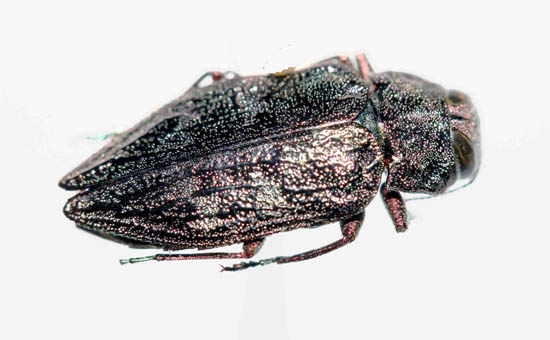Issue 6, May 29, 2009
Flatheaded Appletree Borer
Flatheaded appletree borer, Chrysobothris femorata, is a pest of newly transplanted and declining trees and shrubs in the rose family including hawthorn, serviceberry, crabapple, rose, and cotoneaster. It also attacks many other trees including maple, oak, hickory, sycamore, tuliptree, willow, and ash. It is particularly damaging to young maple trees, tunneling just under the bark in a spiral pattern from near ground level. Such trees are commonly transplanted into landscapes only to die within a year or two from this girdling.

Flatheaded appletree borer larvae are slender, elongate, flattened, white insects with dark mouthparts. The segments are obvious, appearing like flattened beads. Fully grown larvae are about one inch long. They tunnel just under the bark through the cambium, but tunnel deeper into the sapwood to overwinter. These tunnels are oval in shape, about one-quarter inch wide, and filled with sawdust-like frass.

They pupate in the sapwood to emerge as adult beetles at this time of year. These adults are dull metallic-brown to dull gray with indistinct blackish to grayish spots on the back. They are about one-half inch long and somewhat bullet-shaped and flattened. After mating, eggs are laid in bark cracks by the female.

Control on young maples in nurseries and landscapes includes grassy weed control. Attacked trees tend to be found in areas where tall grass is growing. Keeping grass mowed or maintaining grass-free beds may help reduce borer incidence. Keep trees growing vigorously with proper siting, mulching, watering, and fertilizing.
Spray trunks and branches at this time with imidacloprid (Merit, Xytect) or apply as a soil drench or soil injection near the trunk. Remove mulch, sod, and other organic matter before drenching or soil inject below this material. Imidacloprid will bind to dead organic matter and not be taken up by the plant. Because this insect commonly attacks trees dying from old age, treating these trees may not make economic sense.--Phil Nixon
Author:
Phil Nixon